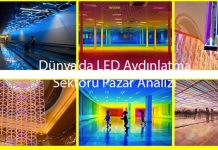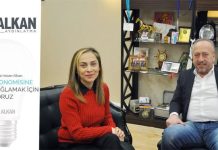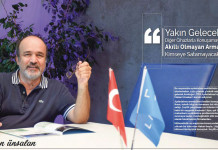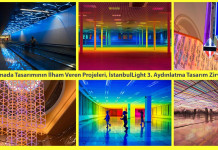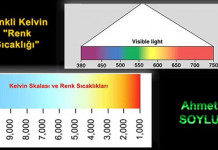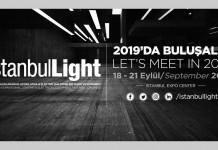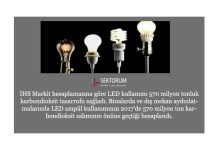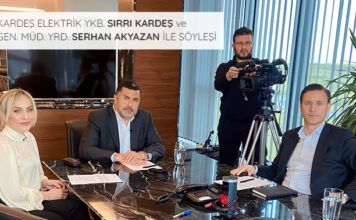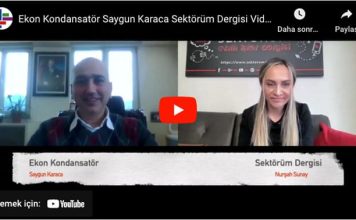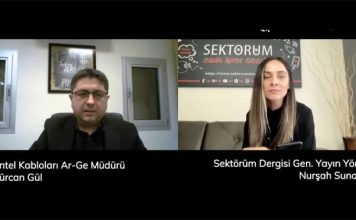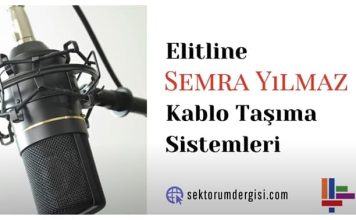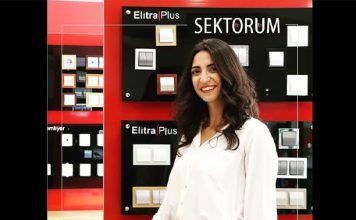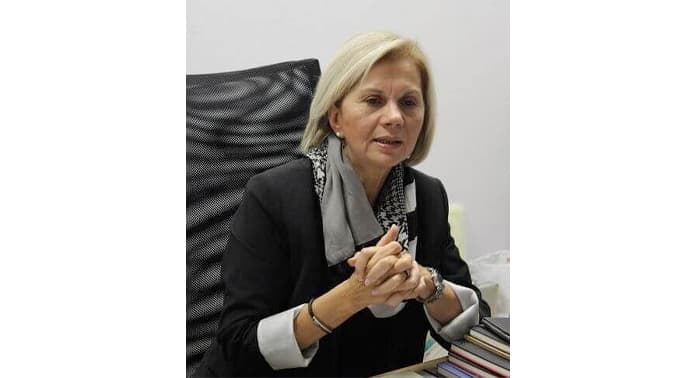
Akademik hayatı boyunca aydınlatmaya duyduğu ilgi sebebiyle, çalışmalarını bu alanda derinleştirerek önemli başarılara imza atan Sermin ONAYGİL, halen ATMK Başkanı ve İTÜ Enerji Planlaması ve Yönetimi Anabilim Dalı Başkanı olarak görevine devam ediyor.
Bir yandan akademisyen kimliğiyle, ülkemiz adına gurur kaynağı olan faaliyetlerini yürütürken; diğer yandan aydınlatma sektörü firmalarına teknolojik alanda daha profesyonel bir sanayi sahası kazandırarak, sektörün gelişimine katkı sağlayan bilgilendirme çalışmalarını sürdürüyor.
Nurşah SUNAY: İzninizle söyleşimiz boyunca size Sermin hoca olarak hitap etmek istiyorum. Okurlarımıza sunmak üzere soracağımız birçok başlık var.
Bununla beraber oldukça zengin akademik kariyeriniz ve çalışmalarınız hakkında bize anlatacaklarınızı dinlemek isteriz.
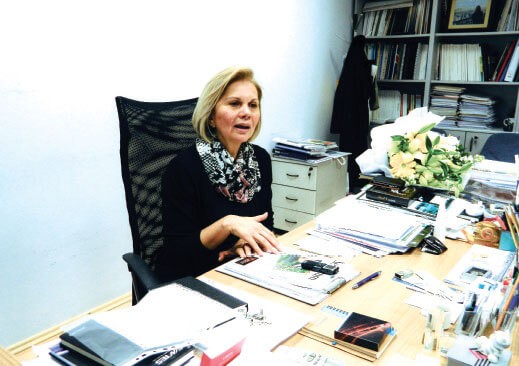
“Sermin ONAYGİL”:Temel olarak hep aydınlatmayla iç içe olma şansını yakalamış, ender kişilerden birisiyim.
Türkiye’de belli bir konuda uzmanlaşmak bazen bir şans ya da olayların birbirini takip etmesini gerektiriyor. Temelde ben bir elektrik mühendisiyim. Mezun olduktan sonra, İTÜ Elektrik-Elektronik Fakültesi’nde aydınlatma üzerine çalışmaya devam ettim.
İlk çalışma yıllarımdan bu yana işin teknik tarafını ve aydınlatma konusunu çok sevdim ve bu alanda yoğunlaştım. Çalışma hayatım tamamen akademik ortamda geçti.
Özel sektörde hiç çalışmadım. Özel sektörle ilişki boyutum, danışmanlıklar ve projeler şeklinde oldu.Konumuz uygulamaya çok yatkın olduğu için, bilgilerimizin uygulama alanında da yer alması gerekiyordu.Özel sektörde uygulandığı ve sonuçları gözlemlendiği sürece çalışmalarımızı daha doğru yönlendirebiliyoruz.Bu açıdan akademik taraf ile özel sektörün uyumuna ve birlikte çalışabilmesine çok önem veriyorum.
Özet Bölümü
- Lisans bitirme tezim yol aydınlatmasıydı
- Aydınlatma sektörünün akademik yönden geçmişten bugüne bir portresini çizsek, durumu nasıl değerlendirirsiniz?
- Biraz ATMK’dan söz edelim. Protokol gereği yazıların özünde, bu dernekle tam olarak hedeflenen neydi?
- Yakın zamanda bunun olabileceğini düşünüyor musunuz?
- Üye sayısının çok daha fazla olabileceğini düşünüyorum. Üye olmak isteyen firmalar için aradığınız özel şartlar var mı?
- ATMK’nın İstanbullight Fuarı içinde durduğu yer neresi?
- Halbuki sektörde NTSR bu fuarın sahibi ve ATMK ile AGİD destek veren kuruluşlar olarak biliniyor.
- LED aslında yeni bir teknoloji değil.
- Tarafsız bir kuruluş olarak AGİD’le beraber akredite olmuş bir laboratuvar kurmayı hiç düşünmediniz mi?
- N.S: Sermin hocam, bu keyifli söyleşi için Sektörüm Dergisi ve okurlarımız adına size çok teşekkür ediyorum.
- A Private Interview With Prof Dr. Sermin ONAYGİL Who is Sermin ONAYGİL ?
Lisans bitirme tezim yol aydınlatmasıydı
Lisans bitirme tezim yol aydınlatmasıydı. Bugün hazır programlarla yapılan çalışmaları, o dönem algoritmayı öğrenerek, programlarını bizzat kendimiz hazırlayarak çalıştık.
Bence uzmanlık için temel bilgilerin yeterli olması gerekli bir koşuldur. Günümüzde aydınlatmanın popülerliğinin artması çok iyi bir gelişme olmasına rağmen, temel konularda bilgi sahibi olmayan kişilerin de çalışma olanağı bulabilmesini işin tehlikeli tarafı olarak görüyorum.
Yüksek lisans tezimde ise bina dış yüzeylerinin aydınlatılması konusunu seçtim ve uygulamalı olarak (Selimiye Camii) bitirdim.
Doktorada ise tünel aydınlatması çalıştım. Bütün tezlerimle hep aydınlatma konusunda var olmaya gayret ettim. 1996’dan sonra Aydınlatma Türk Milli Komitesi (ATMK)’nin kurulması ve Uluslararası Aydınlatma Komisyonu (CIE)’na resmen üye olunması süreci başladı.
Farklı görevlerle hep yönetim kurulunda görev yaptım ve bu dönem de Başkan olarak çalışmalarımı sürdürüyorum.
Aydınlatma sektörünün akademik yönden geçmişten bugüne bir portresini çizsek, durumu nasıl değerlendirirsiniz?
Sermin Onaygil: Aydınlatmaya uzmanlık alanı olarak baktığınızda, ülkemizdeki uygulamalarda, elektrik mühendislerinin çalışmaları var elbette.

Ama bu çalışmalar çoğunlukla yüzeysel kalabiliyor. Mimarlık disiplini içerisinde aydınlatma; gün ışığının doğru kullanılması, dekoratif olarak bir obje olarak değerlendirilmesi, yapılan dekorasyonların istenilen şekilde geri gösterilmesi gibi kavramlar kapsamında önemli bir araçtır.
Dış aydınlatma da peyzaj mimarisi gibi farklı dekorasyon özellikleri nedeniyle daima mimarinin içerisinde yer bulmuş bir disiplindir.
Diğer yandan temelde aydınlatma; ölçülebilen, değerlendirilebilen ve kuralları belli olan somut bir bilim dalıdır.
Doğru ayrımlar yaptığınız zaman bu disiplinlerin de yerini doğru olarak belirleyebilirsiniz.
Örneğin yol aydınlatması, stadyum, ofis ya da sınıf aydınlatmaları gibi, bir görme olayını esas alan ortamları değerlendirirsek, kritik aydınlatma hesap tekniklerine ihtiyacımız olacaktır.
Fakat bir otelin lobisinden ya da dış cephe aydınlatmasından bahsediyorsak kendine özgü biraz daha esnek kuralları olabilir. Bu gibi uygulamalarda dekoratif özellik de önemlidir.
Bugün bilgiye ulaşmak çok kolay, eskiden böyle değildi. Doktora tez çalışmamı gerçekleştirirken araştırmalarını okuduğum kişilerle daha sonra uluslararası platformlarda bir araya gelip, onlarla konuşma şansı yakalamak gerçekten heyecan verici.
Bu bir disiplin, hatta bir hayat tarzı. Yoğun ve özverili çalışmak zorundasınız. Akademik hayatın kendine göre gerekleri vardır.
İşin ticari boyutuna baktığınızda, tabii ki maddi getiriler beklenmesi gerekiyor. Ticari hayat bunu gerektirir. Diğer yandan bizler de akademik olarak özel sektöre katkı sağlamak durumundayız.
Çalışmalı ama ticarileşmemeliyiz. Herkese eşit mesafede olmanız gerekiyor. Bu çok ince bir çizgidir. Zaman zaman zorlanarak, bu dengeyi iyi kurduğuma inanıyorum.
ATMK aslında 1996 yılından sonra sağladığı uluslararası açılımlar nedeniyle akademik hayatta aydınlatmayla ilgilenen arkadaşlarımıza büyük bir açılım olmuştur.
Biraz ATMK’dan söz edelim. Protokol gereği yazıların özünde, bu dernekle tam olarak hedeflenen neydi?
- Sermin Onaygil : Evet, bir hedefi ve resmi gazetede de yayınlanan bir amacı var.
ATMK’nın temel amacı, Türkiye’de Aydınlatma ile ilgili var olan akademik ve özel sektör çalışmalarını ortaya çıkararak, bunları uluslararası arenada kuvvetlendirecek boyutta çalışma platformları yaratmak ve ilerlemeleri sürekli olarak güncel bir şekilde uygulamaya aktarmaktır.
- N.S: Sermin hocam, özel sektörle akademisyenlerin birlikte yaptıkları çalışmalar ve ilişki boyutları çabalarınızla son yıllarda oldukça artmış olsa da bu ayrım ve karşı duruş hala devam ediyor. Sektörel gelişim için bu bir zorluk yaratmıyor mu?
Sermin Onaygil : Bence ülkemizdeki problem de tam olarak budur. Bu alanda yaşanan probleme çözümün aslında sektörden gelmesi gerekir. Üniversite sanayi iş birliğine bakıldığında, üniversiteler ayrı, uzak kalıyor gibi düşünülebilir, ama burada iki tarafta da hata aranması gerekir.
Bir yandan hükümet politikaları, diğer yandan proje destekleri ile son yıllarda bunun aşıldığını düşünüyorum.
Yine de özel sektör ve üniversiteler, iki farklı disiplindir. Bu disiplinlerin ortak platformda geliştirilmesi için çözülmesi gereken bir problem tanımlanması gerekmektedir.
Akademik hayattaki kişilerin, özel sektörden gelen bir problem üzerinde kendini yetiştirip bunun üzerine çalışması en doğru hareket olur.
ATMK olarak biz bu ilişkilerin güçlendirilmesine gayret gösteriyoruz.
Daha önceki yıllarda teknik bilgilerimiz tam olsa da laboratuvar olanaklarımız eksikti. Halbuki çalıştığımız disiplin için laboratuvar koşulları kesinlikle gerekmektedir.
Bunlar masraflı ve uzun süreçli çalışmalar. Örneğin benim çalışma grubum, gerçekleştirilen projelerle tamamen özel sektörün katkılarıyla İTÜ Enerji Enstitüsü’nde fotometrik ölçüm laboratuvarlarına kavuştu.
Son yıllarda sayıları ondan fazla firmanın kendi olanakları ve projeleri ile aydınlatma fotometri laboratuvarı kurmuş olmaları ülkemiz ve aydınlatma sektörü için çok memnuniyet verici bir gelişmedir.
Aydınlatmanın başlangıç noktası ışık kaynağı, lambadır
Işık yayan kaynağın, lambanın üretilmesinde fizik mühendisliği disiplini çok önemlidir. Işığın üretimi konusunda yurtdışında uygulamalı fizikçiler çalışmaktadır.
ATMK olarak önemli bir hedefimiz de ülkemizde eksikliğini gördüğümüz uygulamalı fizik ve diğer gerekli farklı disiplinlerle bir arada çalışma ortamlarının yaratılabilmesidir.
Çünkü ışığı üretmek ve onu istediğiniz şekilde kumanda etmek tamamen fizik kuralları gerektirmektedir.
Artık üreticilerimiz iyi ve kaliteli üretimlerinin yanı sıra yurt dışına da açılım sağlamış durumdalar. Eksiklerini görüp bunları tamamlama isteğindeler.
Problemi tanımlamak çözüme gitmek demektir. Eskiden teknik tarafı problem olarak görmüyorlardı. Dışa açıldıktan sonra ürünün beraberinde, teknik ayrıntılara ilişkin verileri de vermeleri gerektiğini anladılar.
Tasarımcı sizin verilerinizle hesaplarını yapacak, ürünü uygulayacak ve yaptığı tasarımın uygulandığında gerçek koşullarda da aynı değerde olmasını bekleyecek.
Veri olmadan bunu nasıl yapabilir?
Bu sorunla ilgili mücadele yaklaşık 15 yıldır sürüyor. Son 2-3 yıldır birbirimizi anlamaya gayret sarf ettik. Çok önemli bir ataktı.
2006 yılında özellikle TEDAŞ’taki ‘’Yol aydınlatması armatür şartnamesi’’ ile ilgili değişiklik yapıldıktan sonra, yerli armatür imalatçılarımızın ürün kalitesi ve fotometrik veri gereklilikleri konularında önemli gelişmeler gösterdiklerine şahit olduk.
Bildiğim kadarıyla çalışmada sizin imzanız da var.
Sermin Onaygil: Bizzat çalışma grubunun bir üyesiydim. Çalışmayı grubumuz yönlendirdi. Şunun bilinmesini isterim ki; uluslararası platformda teknik olarak oldukça kuvvetliyiz. Yaptığımız çalışmaları yurt dışında paylaştığımızda aldığımız tepkiler oldukça memnun edici.
Eskiden Türkiye’ye sadece distribütörler ya da burada mal satmak isteyen firmaların ticari temsilcileri gelirdi.
Artık teknik adamlarını yollama zorunluluğu da hissediyorlar. Son yıllarda ekonomik durumun da etkisiyle Avrupa’da Türkiye’nin başı daha dik.
Kendi üretimini istediği şekilde yönlendirme yeteneğine sahip bir ülke konumuna doğru gidiyor. Elde ettikleri de var ama yapması gerekenler de var. Mesela; hep yerli lamba üretim olayının gündeme gelmesi üzerinde önemle durmaktayım.
Yakın zamanda bunun olabileceğini düşünüyor musunuz?
Sermin Onaygil: Olması gerekir. TÜBİTAK’ taki Enerji Verimliliği Teknolojileri yol haritaları içerisinde hep bunu yazıyorum.
N.S: İşin daha çok sanayiciler ve özel sektör tarafında duran bir yayın kuruluşu olarak biliyoruz ki; akademisyen, projeci, yüklenici, uygulamacı ve üretici daima iç içe olmalıdır. ATMK’nın eksikliğini doldurduğu bu önemli platform için onlara ne sağlayabiliriz?
S.O: ATMK tanımlanmış olan görevlerini kendi çabaları, üyelerinin katkılarıyla sürdüren, ama ticari olmayan bir kuruluştur.
Sektörümüz sosyal sorumluluk bilinci içerisinde düzenlediğimiz kongre ve sempozyumlar, yaratılan bilgilendirme ortamları, ihtiyaç duyulan alanlardaki eğitim çalışmalarından istifade edebilirler.
Maalesef bu çalışmalara sektörün ilgisinin az olduğunu da söylemeliyim. ATMK’ nın bu gün itibarı ile üye sayısı 123, bunların 51 tanesi özel sektörden kurumsal üyemiz. Dolayısıyla biz zaten sektör ile iç içe, yeni üyelerimize açık bir kuruluş olarak çalışmalarımızı yürütüyoruz.
Üye sayısının çok daha fazla olabileceğini düşünüyorum. Üye olmak isteyen firmalar için aradığınız özel şartlar var mı?
Sermin Onaygil: Elbette artabilir ve artmalı da. Kurumsal ve kişisel üye olarak iki başlığımız var. Kişisel üyeliklerde baktığımız detaylar daha fazla ama kurumsal üyelerde sektörle iç içe olmak niyetiyle (İki tane ATMK üyesinin referansı yeterlidir) çok zorlaştırmadan ve daha esnek davranıyoruz.
İki yılda bir kongreler düzenliyoruz. Başlangıçta Kasım ayında yapılıyordu. Ama sonra fuarla iç içe olması gerektiğine inandığımız için özverili davrandık ve tarihi Nisan olarak değiştirdik.
Sektörü burada içimize almak için sunumlar yapıyoruz. Mutlaka her oturumda sektör temsilcilerinin yaptığı bir projeyi ya da güvendiği bir uygulamayı orada paylaşıma sunuyoruz.
Bu çok ilgi çekiyor. Sektörün de bizimle iç içe olması gerekiyor. Kongrede sunum yapmak için çok istek alıyoruz.
Bunun için; ATMK üyesi olmak ve İstanbullight Fuarı’na katılmak gibi bazı şartlarımız var. Bu sunumlar son derece yararlı. Yorumları, taktirleri ve eleştirileri aynı ortamda alabiliyoruz.
ATMK’nın İstanbullight Fuarı içinde durduğu yer neresi?
Sermin Onaygil: Bu fuarın oluşumu ATMK’nın kuruluşu ile birlikte 17 yıl öncesi Teknik Üniversite Taşkışla salonlarında gerçekleştirilen sergilere dayanıyor.
Salonlar yetersiz kalınca, aynı yıllarda kurulan ve her zaman yanyana birbirine destek olmaya çalışan AGİD ile biraraya gelip, sektörü kucaklayan bu fuar oluşumuna adım attık.
Farklı fuar firmaları denenerek, son dönemlerde NTSR fuarcılık ile uyumlu ve başarılı bir birliktelik yakaladık. NTSR bir fuar organizasyon firmasıdır. ATMK ve AGİD ise düzenleyen kuruluşlardır.
Halbuki sektörde NTSR bu fuarın sahibi ve ATMK ile AGİD destek veren kuruluşlar olarak biliniyor.
Sermin Onaygil: Hayır, tam tersine NTSR organizasyon için bizim seçtiğimiz bir firmadır. NTSR, AGİD ve ATMK olarak her 15 günde bir toplantı yapıyoruz.
3’lü sözleşmemiz var. Son derece uyumlu, karşılıklı özverili, destekleyici çalışmalar sergilediğimizi düşünüyorum. Her gruptan en az 2 kişi saatlerce toplanıyor ve her aşamadan haberdar oluyoruz.
Bunun doğru algılanması gerekir. Sektöre açılım sağlayacak bir ortam yaratmak için çabalıyoruz. Fuar katılımcıları bile bu komisyonun onayından geçiyor. Özellikle uzak doğudan gelecek firmalar için gerekli incelemeler gerçekleştiriliyor.
ATMK ve AGİD uluslararası platformlarda ülkemizi temsil ediyor. Takdir edersiniz ki bu çalışmaların masrafları, çalışanlarımız, üye olduğumuz birliklerin aidatları var.
Kendi kendilerine yeten kurumlar olarak bu bütçeleri yaratmak üzere, İstanbullight Fuarı bu kurumlar için bir döngü sağlıyor.
Çok açıkça ifade etmek gerekirse, ATMK ve AGİD olarak bu fuarı sahiplenip, yaşatmak, geliştirmek için elimizden gelen gayreti gösteriyoruz, göstermeye de devam edeceğiz.
Sermin hocam LED aydınlatma konusundaki fikirlerinizi de almak isteriz. LED’de henüz standartlar oluşmadığı için mi klasik aydınlatma standartları kullanılıyor?
Sermin Onaygil: Genel aydınlatmaya LED teknolojisinin girmesi 2000’den sonra gerçekleşti. İşin doğrusu 5-6 yıllık mazisi var.
LED aslında yeni bir teknoloji değil.
1900’lü yılların başında üretilmiş ama genel aydınlatma dediğimiz ışığı bol olan, gerekli fonksiyonları yerine getirebilir hale gelmesi için bir evre geçirmesi gerekti.
Bu evre 2000’den sonra oluştu. Bu bağlamda LED aslında bir çip ve onu siz lamba haline getiriyorsunuz. Alıyorsunuz üzerine bir şeyler kaplıyorsunuz modül haline geliyor. Lamba üreticisi gibi tanımlayabilirsiniz. LED üreticileri bu boyutta kalıyor.
Bunun çalışması için gerekli baskı devresi var, elektronik ünitesi var. Bizim elektronikçi arkadaşlarımız kendilerini oraya çok yakın gördüler ve orada kaldılar.
Bizler ise boyuta geldikten sonra ışık kaynağını alıyoruz, armatür haline getiriyoruz. O armatür bir dekoratif armatür veya teknik yol aydınlatması armatürü olabiliyor.
Ona göre ışığa ihtiyacımız var. Koşulları var. Bu koşulların yerine gelmesi için ledin bütün çalışma prensipleri buna göre uygulanmak zorunda.
Bu armatür formatından sonra ölçeceksiniz, hesap yapacaksınız, uygulayacaksınız. O ölçümlerde bizim eski konvansiyonel sistemlerdeki kuralların şu anda geçerli olup olmadığı hala tartışılıyor.
Eksiklik tam da burada..İlk yıllarda LED üreticileri aydınlatmayı bilmiyor, aydınlatmacılar da LED’i bilmiyordu. Bizlere düşen görev buradaki koordinasyonu sağlamak.
Sonuçta son iki senedir birbirimizi anladık. Artık bilgiler yerine oturuyor. 4-5 senedir LED çalışmaktan başka konuya çalışamıyoruz. Raporlar yazıyor, yönlendirmeler yapıyoruz.
Karar mekanizmalarını eğitmeye çalışıyoruz. Böyle olduğu için şuanda iş biraz dikkatli yürüyor. Enerji Bakanlığı’na teşekkürüm var.
ATMK’yı bir danışma kurulu gibi gördü. Son iki seneyi böyle atlattık. Yoksa sistemde yanlış uygulamalar çok fazla olabilecekti. Çok az zararla atlatıldı. Hala işimiz zor. Kimseyi zedelemeden devam etmeliyiz.
Evvelden 100 bin saat ömürlerden bahsediliyordu. Hala daha bu değerlerin nasıl ölçüleceği tartışılıyor ama yüksek güçlü LED’lerde 30.000 saatlerin iyi bir rakam olduğunu söyleyebiliriz.
Yaşanabilecek bütün sorunları başından söyledik. Şimdi herkes bu noktaya geldi. Yine de teknoloji çok hızlı gelişiyor. Şu an söylediğim bilgiler 6 ay sonra değişebilir.
Devlet kanadındaki satın almalarda sektör temsilcileri ucuz olması sebebiyle kalitesiz satın alma yapıldığından, resmi kurumlar ise yanlış rekabet hedefleri sebebiyle, firmaların kalite düşürerek devlete zarar verdiğinden şikayet ediyor. Bu satın almalarda gerekli denetimi yapmak kimin sorumluluğunda?
Sermin Onaygil: Ciddi bir sorundan söz ediyorsunuz. Bu konuda dönüm noktası 2006 yılıdır. Türkiye’de elektrik dağıtım şirketlerindeki özelleştirmelerden dolayı farklı dönemler yaşandı.
Yollar dediğiniz zaman otoyollar vardır orda da ihaleler vardır. Firma ürünü kaliteliyse satabiliyor. Şehir içi yollarda, bağlantı yollarında denetim sorumlusu kimdir noktasında hep soru işareti vardı.
Bir dönem sorumluluk belediyelere aktarıldı. Şimdi yeniden elektrik dağıtım şirketlerinin sorumluluğundadır.
Sadece park bahçeler belediyelerdedir. Son olarak da dağıtım şirketlerinin Ankara’daki TEDAŞ Genel Müdürlüğü’ne, bu yolların kalitesine uygun şekilde aydınlatılıp aydınlatılmadığı, doğru faturalanıp faturalanmadığını denetleme görevi verildi. Bu yepyeni bir süreç.
Tarafsız bir kuruluş olarak AGİD’le beraber akredite olmuş bir laboratuvar kurmayı hiç düşünmediniz mi?
Sermin Onaygil: Bunu ATMK tek başına yapamazdı, bütçemiz yeterli değildi. Bu konuda çok fazla sayıda proje dosyası hazırlandı ama maalesef gerçekleşemedi.
Bizim üniversitemizde laboratuvarımız var, Ar-Ge amaçlı olan bu laboratuvar sektörün ihtiyaçlarına da cevap verebilecek düzeydedir.
Ticari bir kurum değiliz ama ürün kalitesini ölçebilir boyutta olmamız bizim için büyük avantajdır. Bu iş ATMK’nın da desteğiyle AGİD’e de çok yakışır.
ATMK’nin desteğinin gerekli olduğunu, laboratuvarın kurulmasının değil, uzun yıllar kaliteli hizmet verebilmesi gerektiğini düşünerek söylüyorum.
Bunun için de yetişmiş, kalifiye teknik ekibe ihtiyaç vardır. Tarafsız bir kurum laboratuvarı sektör açısından oldukça önemlidir. Yine tarafsız kurumlar olarak, bu konuda İTÜ de dahil tüm üniversiteler mevcut ve yeni kurulmuş laboratuvarları ile ellerinden gelen desteği vermeye hazırdır.
Dolu dolu birçok projeden bahsediyoruz. Bunların sektöre tanıtılması yönünde yapılan PR çalışmalarının daha fazla olması gerekir diye düşünüyorum. Sonuç itibariyle emek verilen bu önemli gelişmeleri sektörün bilmesi de önemli. Burada bir zayıflık olduğunuz düşünüyor musunuz hocam?
Sermin Onaygil: Evet, PR çalışmalarını yürütmede bizler profesyonel değiliz. Biz İTÜ olarak da özel üniversiteler kurulduktan sonra biraz kendimizi tanıtma gereğini duyduk ama hala da tam olarak yapamıyoruz.
Biz işimizde iyiyiz, herkes bizi biliyor düşüncemiz var. Aslında bu bir hata. Bu sürecin daha doğru yönetilmesi açısından, özellikle ATMK olarak faaliyetlerimizi tanıtmakta daha profesyonel davranmaya gayret edeceğiz.
N.S: Sermin hocam, bu keyifli söyleşi için Sektörüm Dergisi ve okurlarımız adına size çok teşekkür ediyorum.
Sermin Onaygil: Çok keyif aldım, ben teşekkür ederim.
A Private Interview With Prof Dr. Sermin ONAYGİL Who is Sermin ONAYGİL ?
Having achieved significant successes by intensifying her studies in lighting due to her interest in it, Sermin ONAYGİL still works as the President of ATMK and Head of İTÜ Energy Planning and Management Department.
While keeping on her studies that are a source of honour for our country with her academic identity, she also continues her informative studies that support the development of the sector as well as granting a more professional field of industry in the technological area to the companies of the sector.
Nurşah SUNAY: With your permission, I would like to address you as Prof. Sermin during our interview. There are numerous topics, about which we are going to ask questions, to present to our readers. In addition, we would also like to listen to you about your rich academic career and studies.
Sermin ONAYGİL: Basically, I am one of the few people who have had the chance to be constantly in the field of lighting. In Turkey, specializing on a particular issue sometimes requires luck or events that come after one another. I am basically an electrical engineer. Upon graduation, I kept on working on lighting at İTÜ Electric-Electronics Faculty.
Since the early years of my studies, I have always enjoyed the technical side of the job and the subject of lighting; thus I have concentrated my studies on this area. My whole work life has been in an academic atmosphere.
I have never worked for private enterprises. My relationship with the private sector has been as counselling and projecting. Since our topic is very well suited for practice; our knowledge needed to be applied in the area of practice.
As long our studies are applied to the private sector and their results are monitored, we can direct our studies more accurately.
My thesis of graduation was on road lighting. We worked by personally preparing the programs, which are ready-made today, through learning the algorithm.
I think, for specialization, the coverage of the basic knowledge is a must. It is a very good development that the popularity of lighting has been increasing recently, however the fact that people lacking the basic knowledge of the field also get the chance to work is the risky part of the deal.
For my Master’s thesis, I chose the exterior building and completed it in an applied approach (Selimiye Mosque). For doctorate, I studied tunnel lighting. With all my theses, I have always tried to make a presence in the issue of lighting. After 1996, the processes of founding Turkish National Committee on Illumination (ATMK) and making it an official member of International Commission of Illumination (CIE) started.
I have always been a member of the board of the directors with various duties, this term I carry on my work as the President.
N.S: If we are to draw a portrait of the lighting sector from an academic perspective, how would you evaluate its current state?
S.O: When we consider lighting as a field of specialization, there sure are studies by electrical engineers in our country.
Yet these studies can mostly have a shallow extent. Also in the discipline of Architecture, lighting is a very important tool that it is used as a decorative object, in concepts like reflecting the decorations in the desired way and in the proper use of daylight.
On the other hand lighting is essentially a solid branch of science that can be measured and evaluated, and that has specific rules.
When you make correct differentiations, you can correctly define the locations of these disciplines. For instance, let’s take mediums like road lighting, stadium, office or classroom lighting, whose core point is to see, into account. In this case we are going to need critical lighting measuring techniques.
However, if a hotel lobby or an exterior lighting is the matter, its can have more flexible and unique rules. In applications like these, decorative feature is also important.
Today, unlike the past, it is very simple to reach information. It was very exciting to have the chance to gather around and talk with the people, whose researches I read while doing my doctorate thesis, in international platforms.
This is a discipline and even a life style. You have got to work with sacrifices. The academic life has requirements of its own.
As for the commercial aspect of the matter, it is natural to expect economic benefits. This is a must of the commercial life. On the other hand, we are to support the private enterprises in an academic way.
We must work but not commercialize. We need to be neutral against everybody. This is a very thin line. I believe, I have managed to sustain this balance even though I have had hard times every now and then.
As a matter of fact, ATMK has been a great opportunity for our fellow researchers that are interested in lighting in an academic sense, thanks to international expansion it has created since 2006.
N.S: What was the main purpose of this association in the core of the statements that are written as the protocol required?
S.O: Yes, it has an aim and a purpose that has been published on the official gazette. Our main aims are to detect the existing academic and private sector studies about lighting in Turkey, and to create platforms of study for them to gain strength in the international arena, and to enable them to progress and to convey them into practice in a modern fashion.
N.S: Prof. Sermin, even though the number of studies, made by academicians and private sector, and the extent of their relationship have grown significantly thanks to your effort in the recent years, the discrimination and opposed views are still in existence. Isn’t this creating a hardship for the development of the sector?
S.O: I think the problem in our country is exactly this. The problem experienced in this area, should actually be addressed by the sector. As for the cooperation of universities and industry, the universities alone can be thought as keeping a distance, nevertheless the guilt must be sought in both sides.
I believe this has been overcome by government policies and project supports in the recent years. Still, universities and the private corporations are two different disciplines. In order for these disciplines to improve in a common platform, the problem needs to be defined.
It would be the best move for the academic people to educate themselves on the problems brought by the private sector and to work on this. As ATMK we are struggling to reinforce these relations.
Formerly, even if we had adequate technical knowledge, we lacked the laboratory means. Yet, for the discipline we work on, the laboratory conditions are absolutely necessary. These are high-cost and long term studies.
For instance, my study group gained a photometrical measurement laboratory at İTÜ Energy Institute through project with the support only from the private sector.
The fact that more than 10 companies have established lighting photometrical laboratories by their own means and projects in the recent years is a very pleasing development for our country and the lighting sector.
The starting point of lighting is the light source-lamp. In the manufacturing of the light source, the lamp, the discipline of Physics Engineering is momentous. In the subject of light generation, practical physicists work in foreign countries.
One other remarkable goal of us as ATMK is to create the suitable environment for the practical physics and other various disciplines to work together, which is a need that we have detected. This is because, generating the light and to control it in the way you want to requires rules of physics.
Now, our manufacturers have opened up to the foreign countries in addition to their high quality production.
They are willing to see their downsides and to improve them. Defining the problem means going to the solution. In the past, they didn’t regard the technical aspects as a problem. After their expansion abroad, they realized that they had to present to the data regarding the technical details along with the product.
The designers will do calculations with the data provided by you, use the product and will expect the design they make to be of the same value in real life conditions. How can they do this without sufficient data? The struggle for this matter has been carried on for 15 years.
For the last 2-3 years, we have tried hard to understand each other. It was a significant move. After the modification on the “list of Road lighting luminary conditions” in TEDAŞ (Turkish Electrical Distribution Inc.) in 2006, we have experienced remarkable developments on product quality and photometrical data requirements by domestic luminary manufacturers.
N.S: As far as I know, you also have your signature on the study..
S.O: I was a member of the study group myself. Our team led the study. I would like to say that we are quite powerful technical in the international platform. The feedbacks we receive when we present our studies abroad are very pleasing.
In the past only distributors or the commercial representatives of the companies that were willing to make sales here used to come to Turkey.
They now feel the obligation to send technical staff as well. With the effects of the latest economic state, Turkey can hold its head higher up in Europe.
It is progressing into a country that is capable of leading its own production in the way it wants. For instance, I put great emphasis on the domestic lamp production issue that comes up all the time.
N.S: Do you think this will be achieved in the near future?
S.O: It must be. I always write about this on the Energy Efficiency Technologies road maps of TÜBİTAK.
N.S: As an institute of publication, which mostly stand by the industrialists and private sector in the business, we are aware that; academicians, projectors, contractors, appliers and the producers should always be hand in hand. For this important platform, which was now fulfilled by ATMK, what can we provide for them?
S.O: ATMK is a non-commercial institution that carries out its defined missions by its own efforts and the contributions of its members. They benefit from the congresses and symposiums, training studies in the required areas, informative atmospheres that are created, all of which we organize with the sense of social responsibility in our sector. Unfortunately, I must say the interest of the sector in these studies is rather low.
ATMK’s current number of members is 123, 51 of these are corporate members from the private sector. Therefore, we are already continuing our studies as an institution that is open for new members.
N.S: I think the number of the members could be much higher. Are there particular conditions for companies that want to be members?
S.O: It can of course increase and it should. We have two topics as corporate members and individual members. The details we pay attention to for our individual members are more in number, but we act more flexible in corporate members with the intention of being hand in hand with the sector (reference from two ATMK members will suffice).
We organized biyearly congresses. It was initially done in every November. But then as we thought it should be within the fair, we have acted with self-sacrifice and changed the date to April.
In order to include the sector within our body, we make presentations here. In each session, we definitely put a project or an application, which is trusted by the sector representatives, on presentation. This attracts much interest. The sector needs to be in cooperation with us. We receive many requests to make presentations in the congress.
For this, we have conditions like being an ATMK member and joining the İstanbullight Fair. These presentations are extremely beneficial. We can receive comments, appreciation and criticisms in the same atmosphere.
N.S: What is standing point of ATMK in the İstanbullight Fair?
S.O: The formation of this fair dates back to the exhibitions that were organized in Taşkışla halls of Teknik University when ATMK was founded 17 years ago. When the halls became inadequate, we got together with AGİD (Lighting Luminaries Manufacturers Association), which was founded in the same years and has always tried to support us, and took a step in creating a fair that embraces the sector.
Upon trying out different fair organization companies, we have recently achieved a harmonious and successful cooperation with NTSR. NTSR is a fair organization company. ATMK and AGİD are the institutions that organize the fair.
N.S: In the sector, on the contrary NTSR is known as the owner this fair and ATMK and AGİD are known as contributing institutions.
S.O: No, on the contrary, NTSR is the company we have chosen for the organization. As NTSR, AGİD and ATMK we hold meeting every 15 days.
We have a triple contract. I believe we have made mutual sacrificing and supporting studies in harmony. At least 2 people from each group make the meeting for hours and we are notified about every step.
This should be properly regarded. We are trying to create an atmosphere that will provide an expansion for the sector. Even the fair participants, pass through the approval of this commission. The necessary studies are done for the companies especial from Far East.
ATMK and AGİD represent our country on an international basis. As you can guess, there are expenditures of these studies, our employees and the subscription fee of the associations, which we are a member of.
As for institutions that are self-sufficient to create their own budgets, İstanbullight Fair provides the circulation for these institutions. To be very frank, as ATMK and AGİD, we have been putting a lot of effort in embracing, sustaining and developing this fair, and we will keep doing this.
N.S: Prof. Sermin, we also would like to get your opinions on LED lighting. Are the conventional lighting standards still in use because the standards haven’t been formed in LED yet?
S.O: The entrance of led technology into general lighting, occurred after 2000. To be honest, it has a history of 5-6 years. As a matter of fact, led is not a new technology.It was first produced in early 1900s, but it had to undergo a process to be capable of fulfilling the required functions for general lighting which needs much light.
This phase was completed after 2000. In this sense, LED is a chip and you turn it into a lamp. You take it and cover it with a material to make a module. You can define this as lamp manufacturer. LED makers are confined to this extent.
For this to work, there is a printed circuit and electronic unit needed. Our fellow electronics manufacturers considered themselves close to that area and stick to it. We take the light source at that point and turn it into a luminary.
That luminary can be a decorative luminary or technical road lighting luminary. We need light that suits this. There are conditions. In order to meet these conditions, all of led’s operating principles need to be adapted to this.
After this luminary form, you have got to measure, make calculations and implement them. Whether the rules of conventional systems are now valid for those measurements or not is still debated. There lies the insufficiency.
In the early years LED makers didn’t know lighting and lighting manufacturers didn’t know about LED. Our mission is to provide coordination at this point.
At last, for the last two years we have grown an understanding within each other. Now the data pieces are fitting into their places. For the last 4-5 years we haven’t had time to study a topic other than LED.
We write reports and make directions. We are trying to train the decision making systems. As this is the way it goes now, the job is done more carefully now. I have thanks to present to the Ministry of Energy.
It has considered ATMK as a board of counsellors. We have gone through the past 2 years in this way. Otherwise, the malpractices in the system would be a lot more. It was made through with minimum damage.
Still, we have a hard job to do. We need to carry on without harming anybody. There used to be talks of 100 thousand hours of life.
How these values are to be measured is still in discussion, but we can say 30.000 hours is an ideal number for high-power LED’s.
We have predicted all the problems that can be experienced. Now everybody has come to this point. However, the technology is advancing very fast. This data I am telling right now can change in 6 months.
N.S: For the government purchases, the representatives of the sector complain that low-quality goods are purchased because of their low prices, and the formal institutions complain that the companies harm the government by decreasing quality due to unjust rivalry.
Who is in charge of doing the required inspection on these purchases?
S.O: You have mentioned a serious problem here. The turning point for this is the year 2006. There have been different times in Turkey, due to the privatization processes of electricity distribution companies.
As for roads, there are highways, and they have bids of their own. The company can sell the product if it is of high quality. There is also doubt over who is in charge of inspection for the city roads and link roads.
For a time, this responsibility was laid over to the municipalities. They are now within the jurisdiction of the electricity distribution companies. Only the parks and gardens are within the responsibility of municipalities.
Recently, Tedaş’s General Management office of the electricity distribution companies in Ankara, was given the duty of inspecting whether these roads are lighted properly according to their quality, and whether they are properly billed. This is a whole new process.
N.S: As an unbiased institution, have you ever not thought of establishing an accredited laboratory with AGID?
S.O: ATMK wouldn’t be able do this by itself, our budget was not enough. On this point, lots of project files have been prepared but unfortunately, they couldn’t be actualised. In our university we have a lab.
This lab that has the aim of R&D is on a level that can meet the needs of the sector. We are not a commercial institution but that we are on the level of being able to measure the quality of products is a great advantage for us.
This suits Agid well with the support of ATMK. I say this thinking that the support of ATMK is necessary, the lab must not only be established, it also should give high quality service for long years. For this we need a trained and qualified technical team.
An unbiased institution lab is pretty significant for the sector. Again as the unbiased institutions, all the universities including İTÜ are ready to give any support they can with their current, new built labs.
N.S: We are talking about many comprehensive projects. I think PR studies that are done to publicize them to the sector should be more. After all, it is important that the sector should know these significant improvements, too. Do you think that you have a weakness in this respect, Prof. Sermin?
S.O: Yes, we are not professional in doing PR studies. As İTÜ , we felt the need to introduce ourselves after private universities were established but we cannot still do this properly. We are good at our business. We have the idea that everybody knows us.
In fact, it is a mistake. In the respect that this process is managed better, as ATMK, we will make effort to behave more professionally especially in order to publicize our activities.
N.S: Prof. Sermin, thank you for this delightful conversation on behalf of our readers .
S.O: I also enjoyed it very much, thank you.
güncelleme : 14/05/2019

